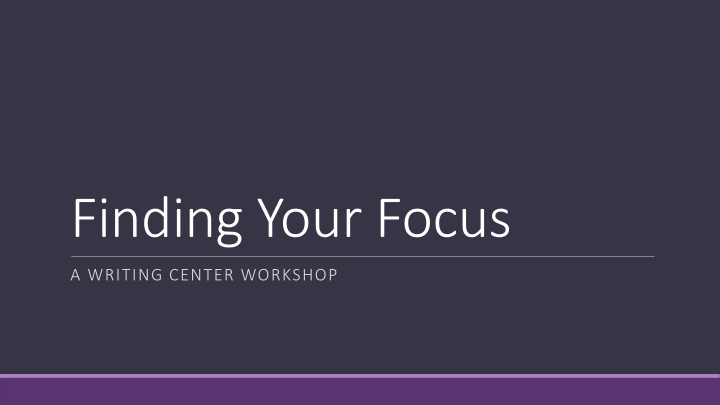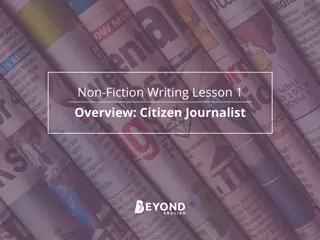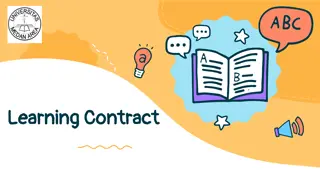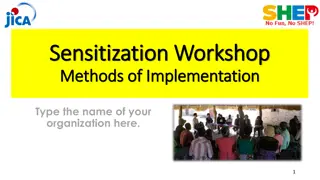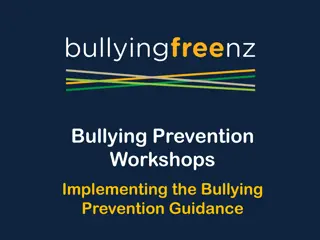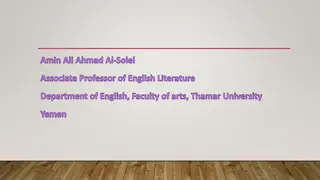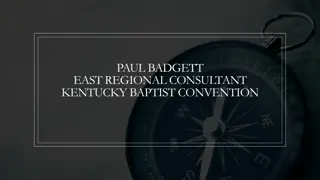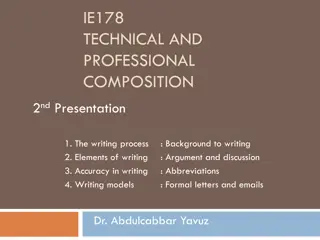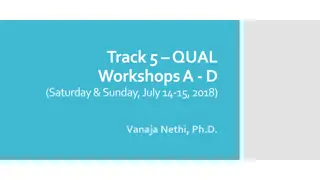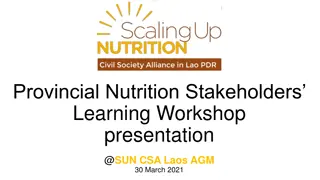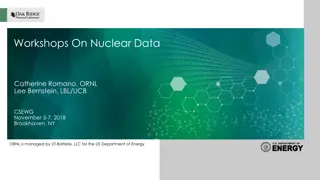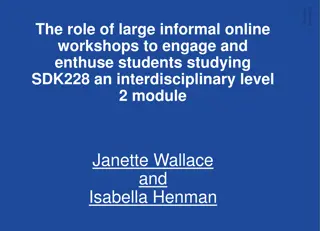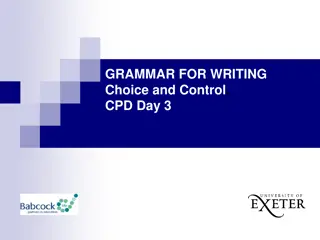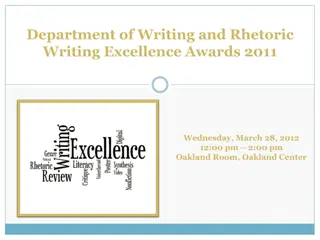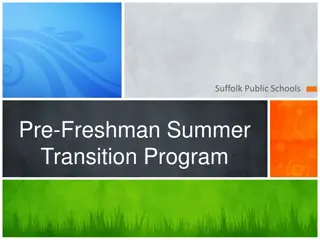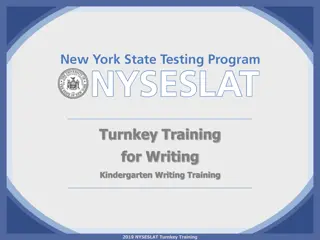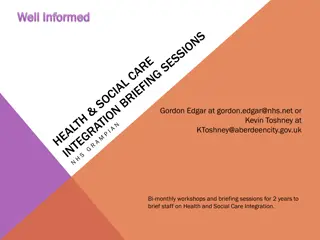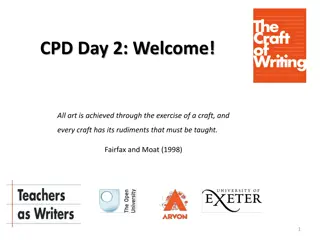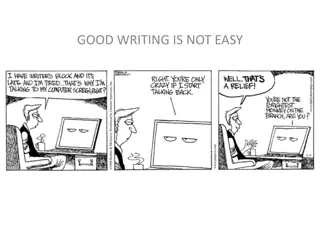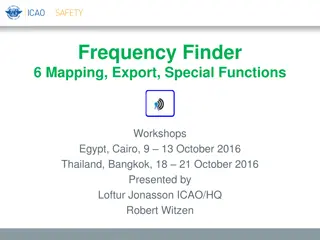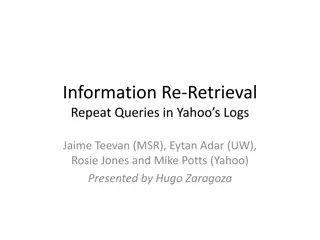Finding Your Focus in Writing Workshops
In a writing center workshop, the focus is on the assignment, not yourself. Understand the writing process, know the assignment, determine your purpose, and select a topic following key factors. Whether instructor-directed or student-directed, composing a cohesive essay is essential. Utilize various sources and make meaning for your audience.
Download Presentation

Please find below an Image/Link to download the presentation.
The content on the website is provided AS IS for your information and personal use only. It may not be sold, licensed, or shared on other websites without obtaining consent from the author.If you encounter any issues during the download, it is possible that the publisher has removed the file from their server.
You are allowed to download the files provided on this website for personal or commercial use, subject to the condition that they are used lawfully. All files are the property of their respective owners.
The content on the website is provided AS IS for your information and personal use only. It may not be sold, licensed, or shared on other websites without obtaining consent from the author.
E N D
Presentation Transcript
Finding Your Focus A WRITING CENTER WORKSHOP
Newsflash: You are not the focus of your paper. The assignment is your focus. Your only job is to write what is relevant and what you can support.
The Writing Process The Writing Process 1. Brainstorming (Inventing & Collecting) (Prewriting & research) 2. Organizing (Outlining) 3. Drafting (First time in paragraph form) 4. Revising (Editing: adding, cutting, moving) 5. Proofreading (Checking grammar, spelling, etc.) Finding you focus: The writing process. (n.d.). Retrieved from https://hcc.instructure.com/courses/41880/files/1959066/download?wrap=1
Step One: Know and Understand the Assignment 1. Read the assignment sheet. Ask your instructor questions if you don t understand any part of it. 2. Questions you should ask: How long should this assignment be? How many sources should I use? Also, am I limited in the types of sources I am allowed to use? What are the formatting requirements (i.e. font, spacing, margins)? When is the assignment due? 3. Determine the purpose of the assignment and how it relates to the themes and objectives of the course.
Purpose Know your purpose for writing What is the point you want to make? This may take research Be as specific as possible Only include information that supports the focus
Topic Selection The Broad View Determines the direction of your paper. Generally follows the direction of the topics/theories learned in class. Determine the Key Factor There are typically two types of assignments: Instructor Directed (Instructor selects the assignment for students) Student Directed (Students select their own topic)
Instructor Topic Selection When your instructor selects a topic for you, remember the following: Compose a cohesive essay that flows smoothly from one topic to the next. Do not merely answer questions. Do not rely on the internet: utilize a variety of print and digital sources. Do more than present information. Make meaning of the material for your audience. Meet with your instructor during office hours to gain his/her perspective.
Student Topic Selection Student Topic Selection can be tricky. Avoid pitfalls by: Researching topics of interest. Focusing on topics that meet the instructor s requirements. Asking questions when you need assistance. Reviewing your selected topic with your professor before proceeding. Staying away from topics that have been overdone (e.g. abortion, gun control, death penalty, drug legalization)
Step Two: Brainstorming/Idea Mapping Write down all ideas that come to mind that can fulfill the requirements of the paper Choose a couple of those topics and write down the key points you would use Choose the topic that interests you most
Other Methods Freewrite: Take a sheet of paper and write down everything you know about the topic The Four A s: Agree, Argue, Assumptions, Aspire to know Journalistic Questions: Who? What? Where? When? Why? How? Pro/Con List: List the benefits or positive aspects of the assignment alongside the detriments or negative aspects Webbing: Write the main topic in the center of the page. Move out from the center and jot down words and phrases you associate with the main topic Venn Diagram (For compare/contrast papers): Use two circles to represent two different topics and determine where they overlap
Step Three: Create an Outline Use an outline to make sure that you stay focused throughout your paper This does not need to be formal It can guide through your paragraphs and help you transition Everything in the body will support the focus statement
Thesis Statement Develop a thesis statement Include all of your key points in one or two concise sentences Let your reader know where your paper is leading Do not confuse a thesis statement with a purpose statement (ex.: The purpose of this paper is to . . .) or a research statement (ex.: In this paper I will . . . )
Learning to Read Critically
Purpose To demonstrate your knowledge of a subject. To familiarize yourself with various methods and styles of discourse. To evaluate the validity of an individual s claims. To form judgments about the text and understand it.
What is critical reading? READING CRITICAL READING Absorbing/Understanding Analyzing/Interpreting/Evaluating What is the text communicating? How does the text work? Taking for granted the text is right? Arguing against the text Restating/Summarizing Interpreting/Evaluating
How to Annotate Start reading Highlight/underline passages you feel convey the central idea of the text Circle words and phrases you do not understand; look them up in a dictionary; jot down their definition Use symbols: stars, exclamation points, question marks, etc. Write a brief summary of the key points of each chapter/section
How to Annotate (Cont.) Use the inside of the book cover to note pages where vital information can be found (reverse index) Make at least 3 annotations per page Be consistent Resist the urge to highlight everything
Strategies Read the introduction and conclusion thoroughly. Can you identify the author s thesis? What is each paragraph s topic sentence? Identity the form of the book (How many chapters? What are their titles? What language is being used? What tone?)
Process There are three steps in the process of reading critically Step 1: Analysis The act of discovering patterns within a text. Step 2: Interpretation The act of applying meaning to the patterns uncovered. Step 3: Evaluation The act of judging the text as a whole.
Analysis Questions to ask during your analysis What is the text s thesis? What are the support points for the author s thesis? What is the author s evidence to prove their support? What kind of persuasion is the author utilizing? (pathos, logos, ethos) What kind of rhetorical strategies are being used? (definition, explanation, argumentation, narration, etc.) How is the argument organized? (chronological, spatial, from cause to effect, from similarity to different, etc.) What kind of resources are being utilized?
Interpretation Questions to ask while interpreting What types of reasonings are employed? (historical, political, scientific, psychological, philosophical, etc.) What kind of theoretical approach is being used? What is being implied within the text? What is the text s perspective? Are there perspectives being ignored? Is my viewpoint of this text biased?
Evaluation Questions to ask when evaluating Is the argument valid? Are the main points supported? Are the examples legit? Are the sources credible? Is the thesis logically persuading? Does the argument support the discipline?
Works Cited and Consulted Waterloo Student Success Office. (n.d.). Read critically. https://uwaterloo.ca/student- success/files/uploads/files/TipSheet_ReadCritically.pdf Retrieved from success/sites/ca.student-
